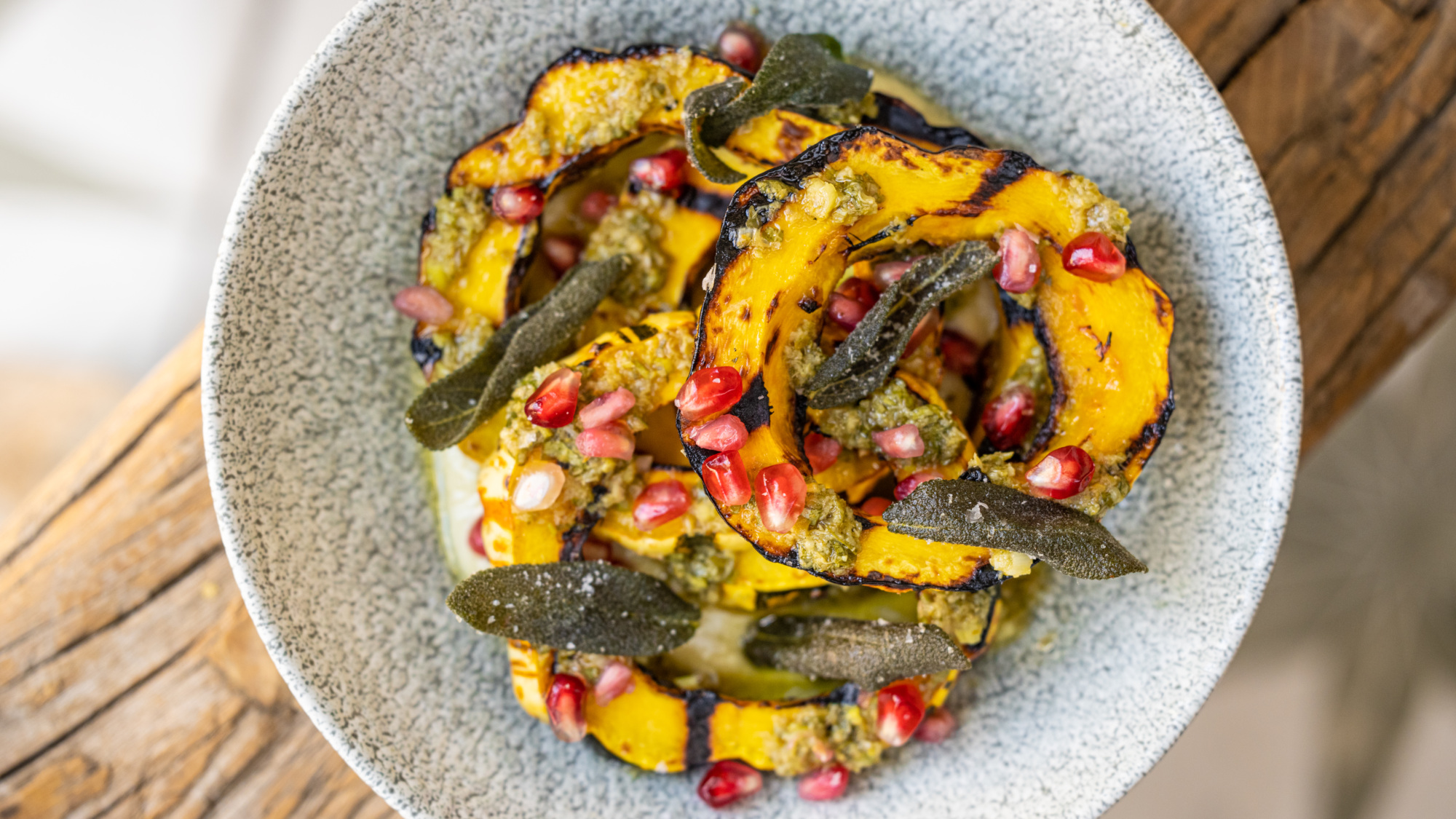
Dominique Crisp’s Thoughtful Basque-Inspired Cuisine at Saso, In Five Dishes
Dominique Crisp’s Saso, a Basque-inspired restaurant hyperfocused on local and sustainable coastal cuisine, is the chef-owner’s love letter to all the culinary twists and turns he’s taken in his life.
Born on his family’s 150-acre vineyard in the rural community of Wren, Ore. the descendant of three generations’ worth of farmers, Crisp has always felt a kinship to the land and what it has to offer.
“It has a lot to do with nature and respect and giving back — that whole cycle just really resonates with me — and when I’m back home, I feel completely connected to the planet,” Crisp says.
He learned from his father at an early age the importance of building relationships with farmers, something he’s carried with him to Saso through his close friendships with fishermen and purveyors. Crisp also takes a thoughtful approach with his ingredients.
“Saso is a seafood extravaganza and a labor of love to get the freshest and best that we can possibly find,” he says. “We are selling seafood that is in season [like] Dungeness crab, and when the season ends, we’ll turn to box crab or even lobster. But those are things that we choose because they’re sustainably farmed and they’re amazing, consistent products, and we’re proud to serve them.”
He takes joy in offering Kerwee wagyu — tender beef from a small-production farm in Australia — which he serves bone-in and Navarra-style. Or he’ll add Roncal cheese, which hails from the Basque region, into his mushroom rigatoni to “kick the dish to another level.”
Crisp’s approach to hospitality and cooking also stemmed from an early age. He started working at restaurants at 15, taking on every job from dishwasher to front-of-house. But he got a taste of European slow food cuisine when he staged at Bistrot de Pays in Southern France. After taking a few more trips to France to work in restaurants, and later in the kitchens of Portland establishments, he landed at L&E Oyster Bar in Los Angeles, where he moved up the ranks from sous chef to executive chef. By the time he helmed Blue Plate Oysterette in Santa Monica, Crisp had gained a wealth of experience working with seafood.
But one of his most memorable trips to Europe was to the Basque Country — where he found himself in a tavern surrounded by chefs making their own cider, preserving asparagus with Pernod, and frying mussels croquettes. In part, the visit inspired him to launch Saso in Pasadena in February 2021.
“When we were in San Sebastian and experiencing pinxtos, where you’re just standing and eating opulent food but it’s completely casual, I was like, ‘This is better than French food. This is what I want to cook. This is what I want my guests to experience. I don’t want tablecloths, I want wood and metal, that slightly industrial feel and for the working class. I don’t want it too pricey.’ I felt that I could give that experience to people in L.A. without sacrificing the quality of my food, and that’s what I’ve done.”
Here, in Crisp’s own words, he details his five standout dishes at Saso.
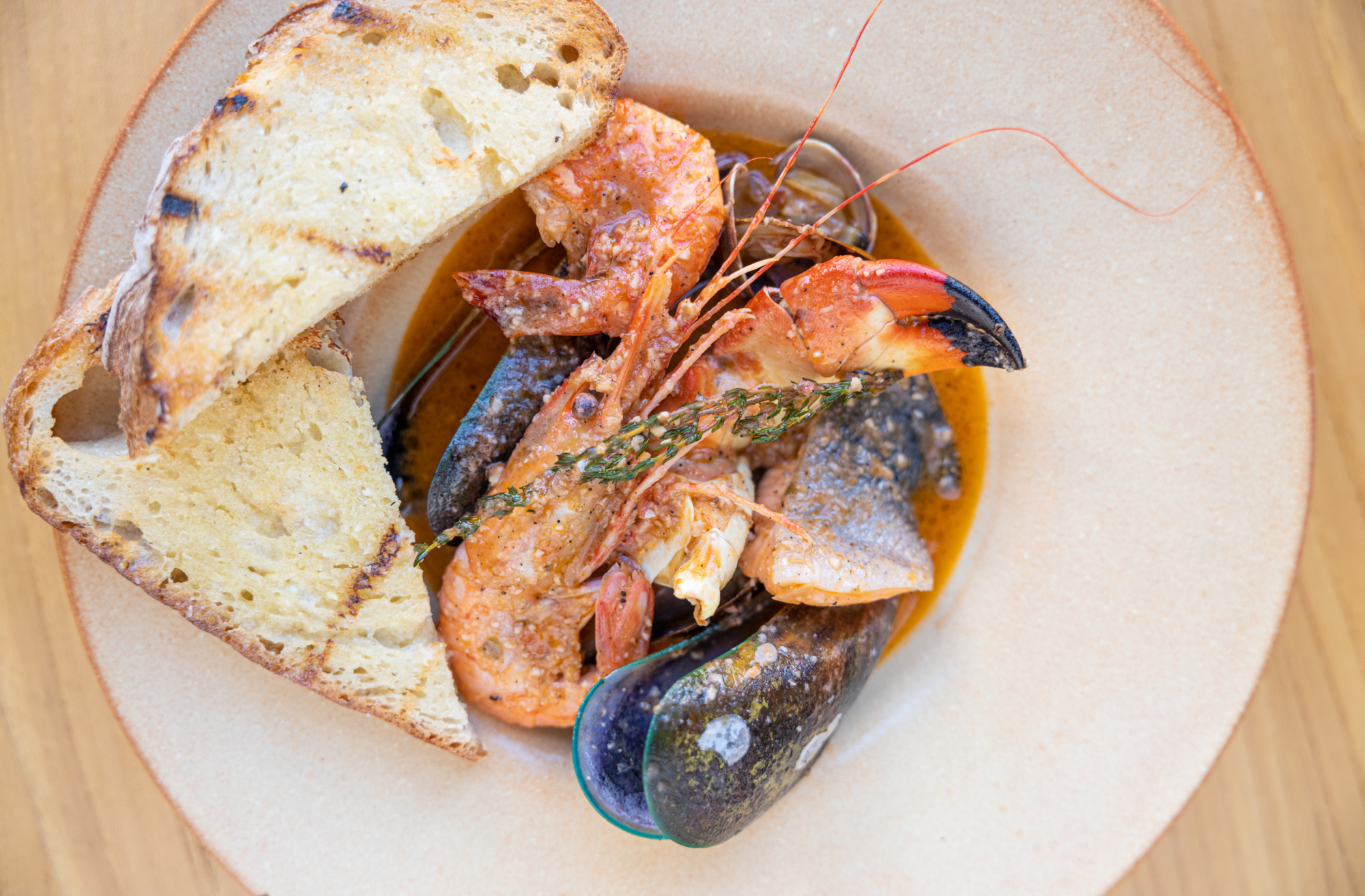
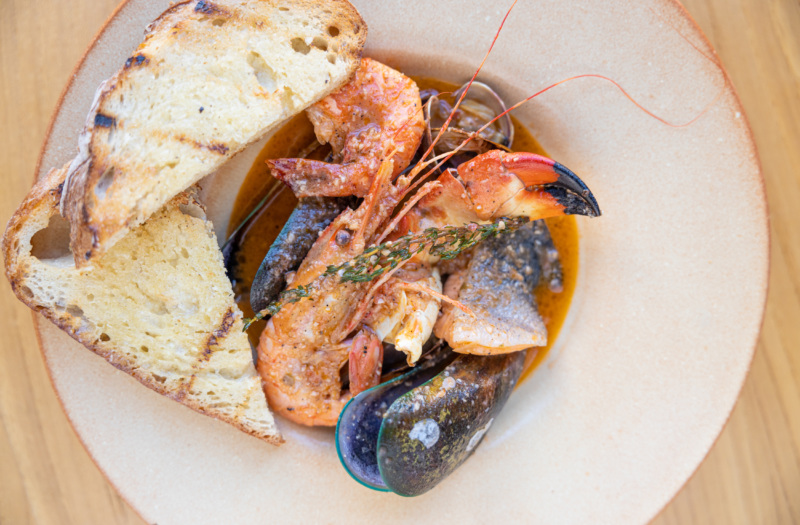
1. Kazola de Marizcos
“The Kazola de Marizcos, also known as cioppino or cacciucco, is a fisherman’s stew. It’s what fishermen eat when they’ve sold all their fish and they have all this extra stuff. They throw it all in a pot and add a little marinara that cuts through some of the fishiness and evens it out.
But mine is à la minute, which means everything goes in the pan in a little bit of oil and then we start building the flavors. We add some thyme, garlic, and butter. Right before the butter browns, we deglaze that with some of my dad’s white wine [from Lumos Wine Company] and add some fish stock that we make almost daily. The fish stock has this kind of great viscosity to it because we use the heads, so it has this gelatinous-ness to it, which gives the Kazola de Marizcos a bit more body. Then we make a special marinara in-house with crushed California Roma tomatoes and Alaskan dried kombu seaweed, which adds extra umami and an extra layer of a sea vegetal taste, another dynamic part of the dish.
And you just hammer at it, like you have to reduce it, reduce it, and reduce it. We throw everything in there. The most important thing is the seafood shells have so much flavor: the clams, mussels, and shrimp, especially, have all this flavor in their shells. You start pulling all that flavor and then you have these oils coming off.
Right now, we’re using salmon in it and then we even throw a crab claw in there for the sweetness. The thyme really gives it this aromatic flavor that’s not overpowering to the seafood. It’s just perfect.”

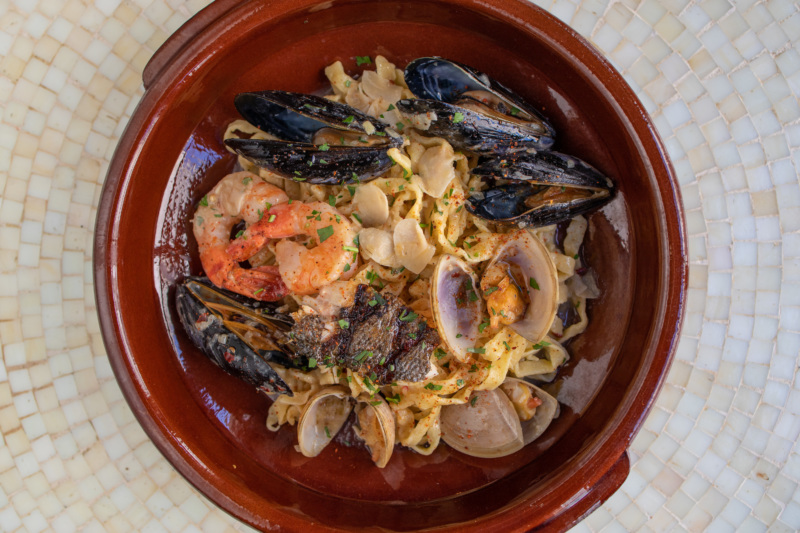
2. Pasta Saso
“The Pasta Saso is a very simple dish that was inspired by the market and also during COVID.
My pastry chef and I were doing hospital meals for the ICU and the ER at PIH Health Good Samaritan Hospital in downtown L.A. We’d take 80 meals a week to them directly and got to know the staff. It was not like, ‘Oh, here are some sandwiches.’ Some days it was like, ‘Here are some sandwiches, but they’re wagyu sandwiches. We’re going to make you really good food so you feel great because you guys are in it right now and we feel for you.’
We also wanted to cook; we were getting antsy. We had a bunch of duck eggs that we got from the market and some really good flour, and we decided to make some duck egg yolk pasta, fettuccine-style noodles.
My homie hit me up and said, ‘We have 40 pounds of clams at this location that we want to give to you because this company won’t take them.’ So, my pastry chef went and got them, and we had to blanch them because we didn’t want to give shells to the staff. We took all the clams, steamed them, got the juices out of them, and made this amazing clam broth. Then we added what we had, which was ginger, shallot, and garlic, and made this insane pasta.
I was like, ‘This is going on the menu like this, but a variation of it.’ I started building it from there because we have all this other seafood, so I added shrimp, fish, mussels, clams … we got everything in there.
Again, it’s an à la minute dish where we deglaze with white wine and add fish stock and a little bit of butter and it just brings the flavors up. The noodles take on the flavor of the sauce; it’s very subtle. It’s about the seafood.”
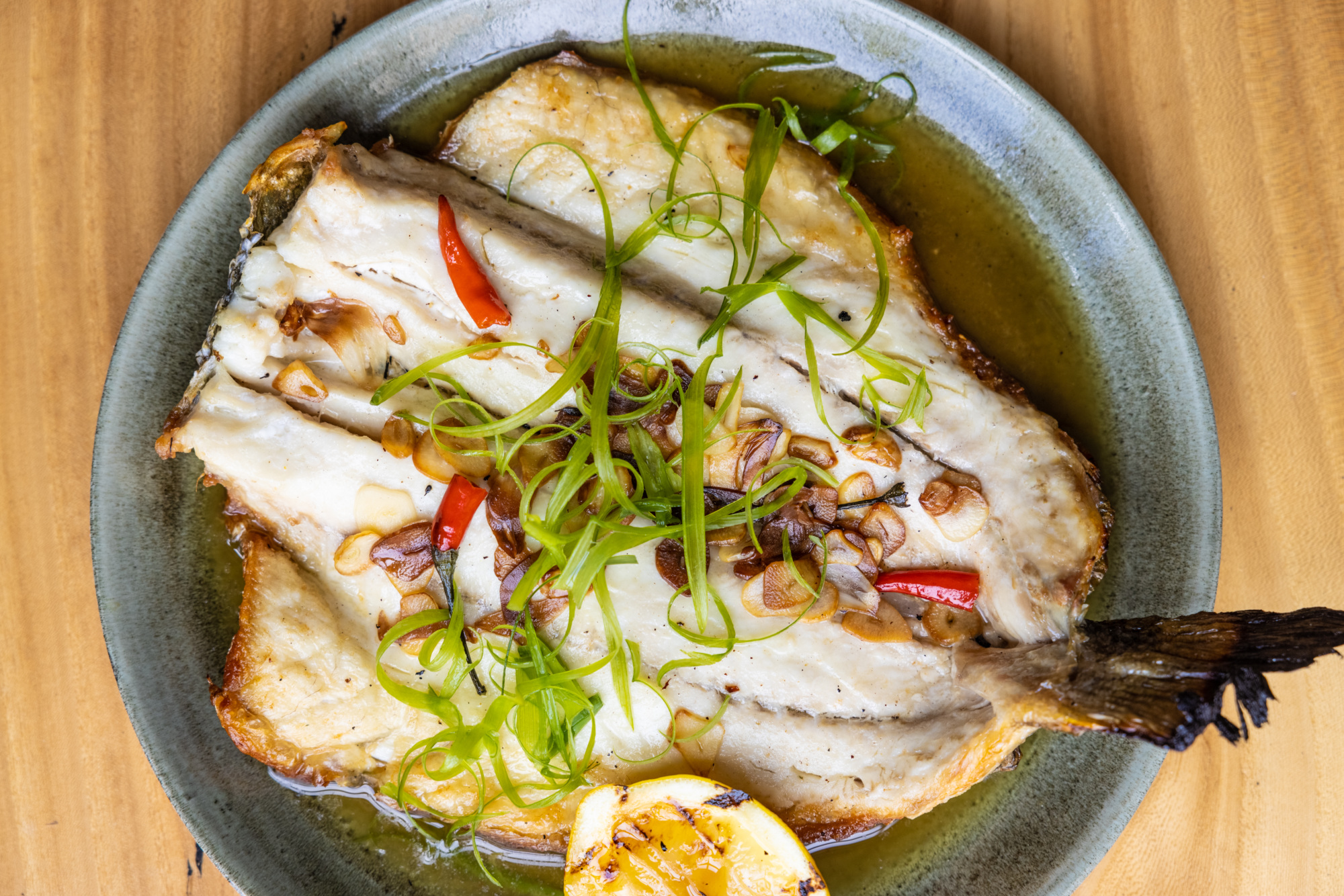
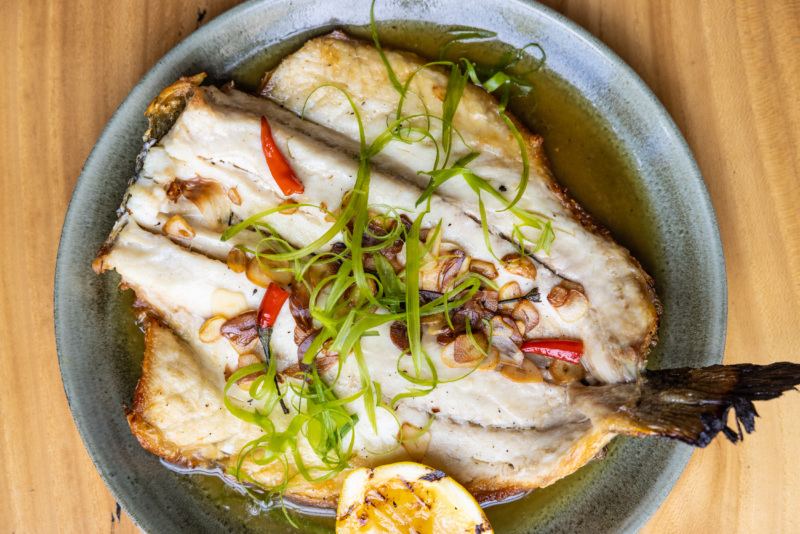
3. Whole Fish Basquaise
The Whole Fish Basquaise is very simple. We sear it and then we put it in the Josper oven to bake, so it takes on the flavor of the charcoal and bakes very quickly. Then we take it out of the pan and put it on the plate, and then whatever is in the pan, which is usually oils from the fish and salt, we add a bit of garlic — and right now, we use bird’s eye chile because it really gives it that great heat kick — and then some more fish stock. If you rock it back and forth, it gets emulsified.
And then you put a little salt on there and you put it on top of the fish. We garnish it with a grilled lemon and some green onion, which is not necessarily Basque — they wouldn’t use it — but it adds an extra layer of texture and flair. It’s just a classic [dish that says,] ‘Hey, this is fish. Enjoy it.’
And we try and rotate that, so some weeks we have three different kinds of fish. We’ll do striped bass, black bass when it’s in season, and local vermillion or dorade. We try to shy away from branzino and stuff like that because everyone has it on their menus and it’s not necessarily local.”

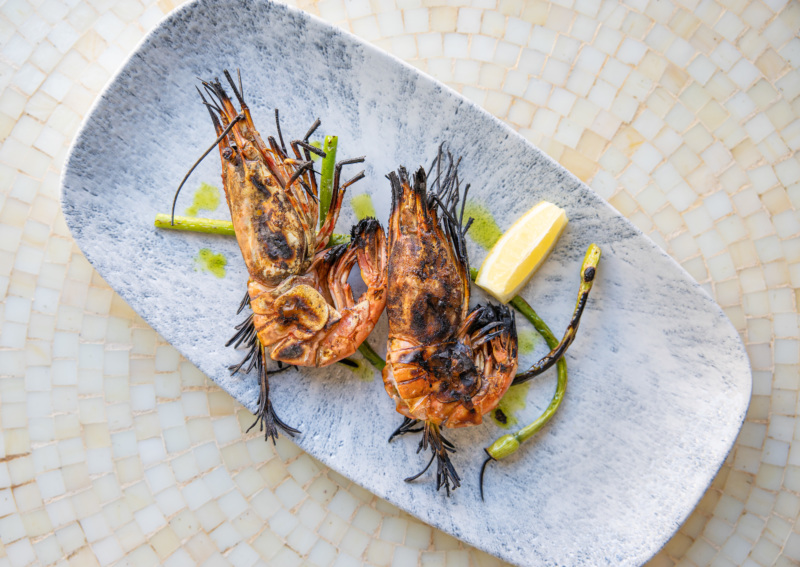
4. Ganbak
“The Ganbak is inspired by great prawns. When we can get spot prawns, it’s the most delectable thing. And it’s expensive, so it’s pretty crazy. I get them from Santa Barbara or San Pedro, depending on how and who I can get them from — it’s all weather permitting.
When I get them, I get them live. So, when you come to Saso when we have them, I tell the team that day that we can do a live preparation where we take the heads off and they’re raw and we serve it with yuzu.
It’s really nice, but the way we do it, it’s kind of barbaric. We cram rosemary in their heads and then we toss them in garlic, salt, and a bit of oil, and then put them in the Josper and cook them very quickly in their own shells.
The rosemary kind of takes the the bite off of the crazy head juices. I like that, but I added the rosemary as an aromatic to cut through it if you weren’t completely married to that flavor.
The meat itself is extremely tender. When you get in there, it’s just the most magnificent thing.”
5. Kalabaza
“Delicata squash is in season. This dish has a cashew and Marcona almonds with sage oil-infused nut butter on the bottom. Then we par-roast the squash in giant chimneys: we cut them into segments and then keep them in cylinders, get all the guts out of the squash, and then par-roast them.
Then when we cook it to order, we cut them into little circles and grill them in the Josper so they get that charcoal flavor. They have a lot of sugar in them, so you don’t need any oil. They get the grill marks on them. And we put them on top of the nut butter or make a caper gremolata. It’s slightly bitter, has a lot of salinity and acid, and it’s got lemon, lemon zest, garlic, and scallions for a bit more bitter flavor and sweetness.
We top it with fresh pomegranate seeds — which adds texture, sweetness, and a bit of citrus — and some toasted sage leaves, which adds even more texture and that aromatic herbaceousness that just screams fall.”
















